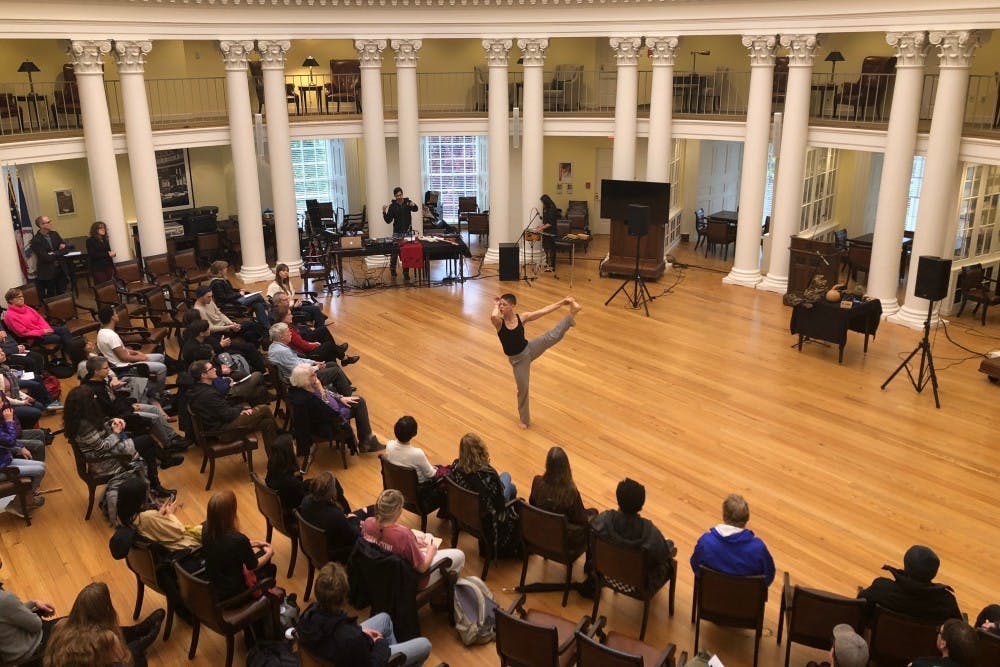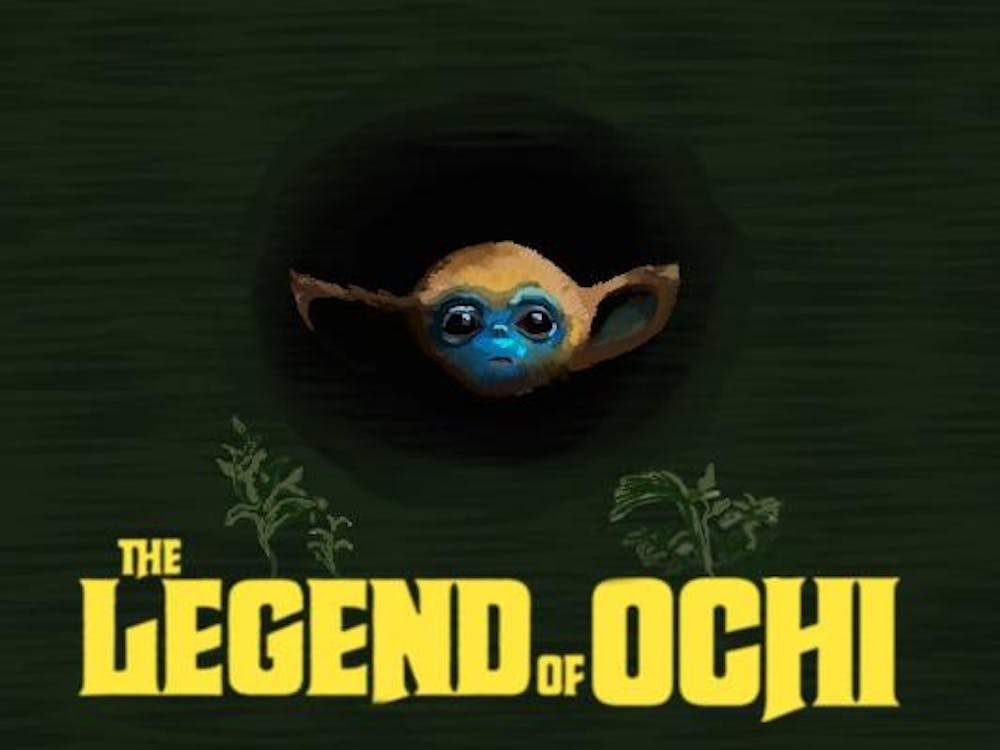I-Jen Fang held a dried gourd up to a microphone and scraped her fingernails across the vegetable’s surface. Thus began her performance at the University’s 2018 Experimental Arts Festival, held in the Dome Room of the Rotunda last Friday. Fang tapped and rubbed the gourd for few seconds, allowing the hollow knocks and staticky scrapes to echo through the Rotunda’s central chamber.
Fang then placed the gourd on the table full of dried plants in front of her. She picked up a pair of large brown leaves and flicked them against each other, then rubbed them harder together. Pressed up against the microphone, the leaves sounded like anything but leaves — fluttering wings, skittering animals, tearing paper. Eventually, Fang ripped the leaves apart, destroying her own instrument, a watered-down, avant-garde mutation of Pete Townshend smashing his guitars into fiery oblivion onstage.
Fang explored eight different plants during her eight-minute performance. She plucked cactus thorns, the gently resonant twangs echoing in the big room. She stroked the stubby needles of two pine cones, the sound almost like staccato notes from a guitar, her eyes wide and body tense as she manipulated the plants. She rustled dried branches, which sounded like an ASMR video of someone eating potato chips.
Fang, a professor of music at the University, took the stage midway through a day-long program designed to highlight experimental artistic practice on Grounds. This year’s festival was the first of its kind, presented by the 2017-18 cohort of the University’s Arts Fellows. Professors from the Drama Department spoke about stand-up comedy and unconventional theater techniques. Poetry faculty and students gave a reading of their work. Other Music Department faculty performed their own innovative compositions.
Just before Fang’s performance, Assoc. Music Prof. Ted Coffey presented his electronic piece “Petals 9.” Fang provided backup percussion and dancer Jennifer Nugent performed alongside the music. “[This piece represents] music as sonics, music as space, music as place,” Coffey warned the audience before he began. “We’re not going to do music-y music.”
Indeed, “Petals 9” sounded unlike anything likely to pop up on a Spotify playlist. Coffey began the song with a few taps of a button, and soon the circular room reverberated with dark, brooding sound. At its best, the music could impart a tremendous sense of atmosphere, and at times the sound built so powerfully that sitting in the Dome Room felt like sitting in the caboose of a freight train or relaxing on a chair in the center of a thundercloud. Other times, Coffey’s myriad digital whines and extended wavering notes induced panicked claustrophobia, like standing next to a shrieking smoke detector without knowing quite how to turn the d–n thing off. Fang lurked in the back of the stage, occasionally puncturing the ambience with a short snare drum riff or a single sharp hit of a wood block.
Coffey spent most of the song’s duration gently poking at the knobs and dials on his soundboard, but on a few occasions he became more involved. He dangled a humming tuning fork in front of a microphone. He played guitar with a violin bow. He set off a spinning top that whistled as it turned. When the top stopped spinning and fell on its side, the last remaining music faded to nothing. Coffey signaled the end of his performance with a nonchalant shrug, and the audience in the Dome Room applauded heartily.
While Coffey carefully moderated the music, Nugent delivered an energetic and outré improvisational dance accompaniment. Nugent began contorting her body in a series of poses, moving slowly from one uncomfortable position to the next. This first phase of her performance seemed to represent a protracted struggle to scratch an itch in a difficult-to-reach spot on the lower back. Dressed in gray pants and a black tank top, she crawled across the floor on all fours, slid rear-end first from one side of the stage to the other and once draped herself over Coffey’s music table.
Over the course of her performance Nugent engaged with a handful of recognizable poses. She briefly flashed a ballerina’s plié before deconstructing the form into something else entirely. She nearly started doing crunches, only to deviate slightly, blurring the line between exercise and dance. She stood wide-legged and jerked her hand through the air in front of her posterior, an unmistakable on-stage impersonation of a person trying to dislodge a bad wedgie. Nugent displayed tremendous stamina, dancing throughout the roughly 20-minute song, pausing only to assume a seat in the audience and watch the empty stage for a moment before resuming.
Coffey and Nugent’s performance was at times mesmerizing, at times unsettling and at times prohibitively weird. After a while the sheer eccentricity became simply silly. An over-the-top interpretive dancer and a black-clad woman rubbing pinecones together — it would be hard to invent a better satire of contemporary art. The whole thing was a half-step away from Will Ferrell, dressed in a black tank top, twirling a ribbon in “Old School.”
The festival performances retained political sharpness, however, thanks to the event’s venue. Successful or not, any experimental art performed in the Dome Room of the Rotunda will feel radical and compelling in some way. The Rotunda is one of the the oldest, most traditional places on Grounds. It is a symbol of this University’s hidebound history. Last week, for a few hours, it was repurposed to explore some of the least conventional, most progressive work being done by artists anywhere. The festival deserves immense credit for its efforts to destabilize U.Va.’s entrenched self-image.
Asst. Art History Prof. Christa Noel Robbins delivered the Festival’s opening remarks and emceed the program. She said the group chose to hold the event in the Rotunda because “we wanted to emphasize experimental practice on Grounds. We thought this is one of the most visible places. It also, for the sound, has wonderful acoustic qualities.”
Robbins felt the Dome Room supplemented the ideas on display in the art. “[The festival] had a really wonderful political resonance, not just acoustic resonance in this space,” Robbins said. “I don’t know if there’s ever been experimental music played in the Dome Room before.”
Coffey also noticed the effect of the room during his performance. During a question and answer session, the music professor said, “I like the idea of making spaces mean what you want them to mean. Writing over what you don’t like. Making new ritual identities.”
The performers at the Experimental Arts Festival delivered a comically outlandish program. Sometimes, though, a little bit of outlandishness is just what the doctor ordered. The Festival represents an admirable attempt to reinterpret well-worn space in a new and modern way. As the University becomes more progressive, reimagining its traditional spaces will be one of the school’s biggest challenges. Art — even if it’s a person plucking cactus needles into a mic — can help lead the way.







